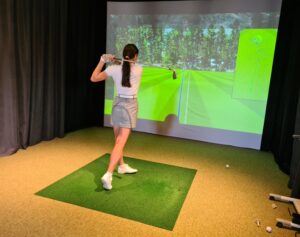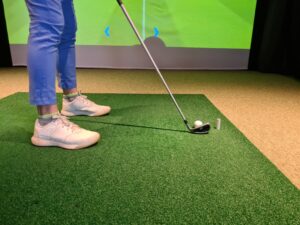Golf simulators have transformed how players experience the game, allowing golf to be played indoors with surprising realism. But many people still wonder: how do golf simulators work? The technology might seem like magic, especially when it recreates full courses and swing data in real-time, but it’s built on a combination of hardware and software that work together seamlessly.
From the moment a golfer takes a swing to when the ball lands on a virtual green, various systems are tracking, processing, and projecting data in a matter of milliseconds. Let’s explore how golf simulators work, what components are involved, and why they’ve become such an effective tool for practice and play.

The Core Technology Behind Golf Simulators
At the heart of every golf simulator is a launch monitor. This device captures detailed data about the golf ball and the club during each shot. The monitor may use radar technology, high-speed cameras, infrared sensors, or a hybrid system to track motion.
Radar-based systems like TrackMan emit microwaves that bounce off the ball and club, calculating speed, spin, and trajectory. Camera-based systems like Foresight GCQuad or SkyTrak use ultra-high-speed lenses to record the impact and initial ball flight. Some simulators combine both technologies to maximize accuracy.
These data points are instantly transmitted to software that uses physics models to simulate ball flight, carry distance, and shot shape. The software then displays the results on a screen, often with high-definition renderings of real-world golf courses.

Tracking Ball Data
Ball data is the most critical element in understanding how golf simulators work. Launch monitors track variables such as:
- Ball speed
- Launch angle
- Spin rate (backspin, sidespin)
- Carry distance
- Smash factor
- Ball flight path
Advanced systems even simulate how different course conditions—such as wind or elevation—would affect the shot. The result is a highly realistic virtual representation of each swing.
Measuring Club Data
In addition to the ball’s behavior, many golf simulators also track the club through impact. This allows for deep swing analysis and coaching. Key metrics include:
- Clubhead speed
- Face angle at impact
- Swing path
- Angle of attack
- Dynamic loft
To capture this data, some simulators require stickers, reflective dots, or specially marked clubs. Others rely on 3D motion tracking or multiple high-speed cameras placed around the hitting zone.

Display and Simulation Software
Once the data is collected, simulation software brings the experience to life. Programs like E6 Connect, TGC 2019, and FSX 2020 render photorealistic golf courses, display shot trajectories, and provide game modes such as driving range, course play, and skills challenges.
This software translates your swing into a visual display, often projected onto a large impact screen or shown on a connected monitor. The ball appears to fly through the virtual sky as though you’re really at Pebble Beach, St. Andrews, or Augusta.
The Role of the Impact Screen and Projector
When wondering how golf simulators work, it’s important not to overlook the hardware that makes it feel real. Impact screens serve a dual purpose: they display the course visuals and safely stop the ball after each shot.
High-quality impact screens are made of tightly woven materials designed to absorb the energy of a fast-moving golf ball without tearing or deforming the image. A projector mounted above or behind the player beams the visuals onto the screen.
Some simulators skip the screen and use a net with a connected monitor for a more compact or budget-friendly setup. However, for the full immersive experience, a screen and projector combination is ideal.
Hitting Mat and Room Environment
The hitting mat mimics the feel of real fairway grass and provides a consistent surface for your stance and swing. Premium mats include different turf textures to simulate fairway, rough, and even putting greens.
The simulator environment must also support accurate tracking. That means proper lighting, enough ceiling height, and a room size that allows a full swing. Many setups also include sound-dampening features or enclosures to reduce distractions and contain the ball.
Interactive Feedback and Coaching Tools
Most modern golf simulators offer interactive feedback in real time. Swing data is displayed after every shot, along with suggestions or graphical overlays. Advanced systems include video replays, shot dispersion charts, and even AI-powered swing tips.
Some facilities, such as Sim Cup Golf in Palm Bay, Florida, use this technology to deliver structured training programs, lessons, and skill challenges. With accurate data and immediate feedback, golfers can track progress and improve technique in a controlled setting.

Multiplayer and Entertainment Features
Golf simulators are not just training tools—they’re also entertainment hubs. Many systems allow for multiplayer play, online tournaments, mini-games, and even integrations with other sports simulations.
Players can compete on famous courses around the world, set up leagues, or enjoy casual games with friends. With customizable avatars, weather conditions, and scoring formats, the simulator becomes a platform for both serious and social golfers.
Commercial Simulator Operation
In commercial settings like Sim Cup Golf, golf simulators are integrated with management software for scheduling, user profiles, payment systems, and event coordination. High-traffic use requires durable components, easy system resets, and tech support to ensure consistent operation.
Commercial simulators also need fast performance and high-resolution visuals to deliver a premium experience. The systems must accommodate players of all heights, skill levels, and preferences, which is why flexibility in configuration is essential.

Conclusion
So, how do golf simulators work? Through a combination of precision sensors, advanced software, immersive visuals, and user-friendly design. They capture every swing in real-time, analyze the data, and present a virtual representation of the shot with surprising accuracy.
From practicing your drive in the offseason to playing 18 holes with friends indoors, simulators bring golf to life in new and exciting ways. At Sim Cup Golf, players experience all of this with top-tier equipment, coaching opportunities, and unforgettable play sessions.
Whether you’re a beginner looking to improve or a seasoned player trying to stay sharp, understanding how golf simulators work is the first step in unlocking their full potential.
Helpful Resources:







